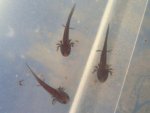Hey guys,
It's just over a month since my first C.Orientalis eggs hatched, and the larvae seem to be doing well.
I've noticed one of the larvae is missing its front two legs (which I'm almost totally certain had developed initially); more precisely, they appear to be significantly reduced in size.
The rest of the larvae, including the limbless one, are just beginning to develop hind legs.
I've read a bit on limb regeneration in adult salamanders, but I'm fairly ignorant when it comes down to same process amongst larvae.
I'm not sure what the cause is. It seems unlikely that they've been bitten off due to overcrowding, and though I'm quite meticulous regarding water changes/quality, I suspect infection could be a likely cause.
I've around 40 larvae, but only one case like this. The larva is currently in a tub on its own.
Any advice or guidance, or accounts of similar experiences, that anyone could offer would be very much appreciated.
Karl
(I'll try and get some photos up soon)
It's just over a month since my first C.Orientalis eggs hatched, and the larvae seem to be doing well.
I've noticed one of the larvae is missing its front two legs (which I'm almost totally certain had developed initially); more precisely, they appear to be significantly reduced in size.
The rest of the larvae, including the limbless one, are just beginning to develop hind legs.
I've read a bit on limb regeneration in adult salamanders, but I'm fairly ignorant when it comes down to same process amongst larvae.
I'm not sure what the cause is. It seems unlikely that they've been bitten off due to overcrowding, and though I'm quite meticulous regarding water changes/quality, I suspect infection could be a likely cause.
I've around 40 larvae, but only one case like this. The larva is currently in a tub on its own.
Any advice or guidance, or accounts of similar experiences, that anyone could offer would be very much appreciated.
Karl
(I'll try and get some photos up soon)

